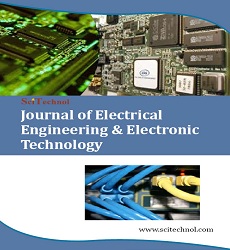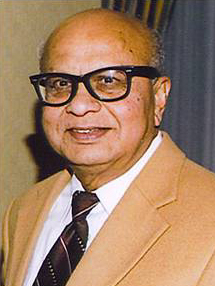About the Journal

Journal of Electrical Engineering and Electronic Technology is a peer-reviewed scholarly journal in the field of electrical engineering and electronics that aims to publish the most complete and reliable source of information on the discoveries and current developments in the mode of research articles, review articles, case reports, short communications, etc. in all areas of electrical engineering and electronics and making them accessible online freely without any restrictions or any other subscriptions to researchers worldwide.
Journal of Electrical Engineering and Electronic Technology focuses on the topics include, but are not restricted to: Microelectronics, Electrical technologies, Reneable Energy, Electrical circuits, Audio and video technology, Wireless sensors, Nanoelectronics, Electrostatics, Signal processing, Digital appliances, Communication systems, Wireless and Mobile Communications, Radio Communication, Power systems, Embedded systems, Semiconductor devices, Analogue circuits, Microwave techniques, Sensors, Robotics, Automotive electronics, Electromagnetic systems, Industrial electronics, VLSI, Optoelectronics.
Submit manuscripts at Online Submission System or send as an e-mail attachment to the Editorial Office at manuscript@scitechnol.com
*official 2016 Journal Impact Factor was established by dividing the number of times the 2014 and 2015 published articles cited in 2015 according to Google search and the Scholar Citation Index database with the number of articles published in 2014 and 2015. If ‘X’ is the total number of articles published in 2014 and 2015, and ‘Y’ is the number of times these articles were cited in indexed journals during 2015 then, impact factor = Y/X.
Dielectrics and Electromagnetics
A dielectric is an electrical insulator that can be polarized by an applied electric field (Electromagnetic fields). When a dielectric is placed in an electric field, electric charges do not flow through the material as they do in a conductor, but only slightly shift from their average equilibrium positions causing dielectric polarization.
Power and Energy system
In physics, power is the rate of doing work. It is equivalent to an amount of energy consumed per unit time. In the SI system, the unit of power is the joule per second (J/s), known as the watt in honour of James Watt, the eighteenth-century developer of the steam engine. The integral of power over time defines the work performed. Because this integral depends on the trajectory of the point of application of the force and torque, this calculation of work is said to be path dependent.
Measurement and Instrumentation
Measurement is the process of determining the amount, degree or capacity by comparison with the accepted standards of the system units being used. Instrumentation is a technology of measurement which serves sciences, engineering, medicine and etc.
Communication System
In telecommunication, a communications system is a collection of individual communications networks, transmission systems, relay stations, tributary stations, and data terminal equipment (DTE) usually capable of interconnection and interoperation to form an integrated whole. The components of a communications system serve a common purpose, are technically compatible, use common procedures, respond to controls, and operate in union. Telecommunications is a method of communication.
Applied Electronics
Applied Electronics is the science of how to control electric energy, energy in which the electrons have a fundamental role. Electronics deals with electrical circuits that involve active electrical components such as vacuum tubes, transistors, diodes and integrated circuits, and associated passive electrical components and interconnection technologies.
Power Electronics and Drives
Power electronics is the application of solid-state electronics to the control and conversion of electric power. It also refers to a subject of research in electronic and electrical engineering which deals with the design, control, computation and integration of nonlinear, time-varying energy-processing electronic systems with fast dynamics.
Control Systems
A control system is a device, or set of devices, that manages, commands, directs or regulates the behaviour of other devices or systems. Industrial control systems are used in industrial production for controlling equipment or machines.
Sensor Networks
A wireless sensor network (WSN) are spatially distributed autonomous sensors to monitor physical or environmental conditions, such as temperature, sound, pressure, etc. and to cooperatively pass their data through the network to a main location. The more modern networks are bi-directional, also enabling control of sensor activity.
Nano Electronics
Nanoelectronics refer to the use of nanotechnology in electronic components. The term covers a diverse set of devices and materials, with the common characteristic that they are so small that inter-atomic interactions and quantum mechanical properties need to be studied extensively.
Remote sensing and Space systems
Remote sensing is the acquisition of information about an object or phenomenon without making physical contact with the object and thus in contrast to on site observation. Remote sensing is a sub-field of geography. In modern usage, the term generally refers to the use of aerial sensor technologies to detect and classify objects on Earth.
Renewable Energy
Renewable energy is generally defined as energy that comes from resources which are naturally replenished on a human timescale, such as sunlight, wind, rain, tides, waves, and geothermal heat. Renewable energy replaces conventional fuels in four distinct areas: electricity generation, air and water heating/cooling, motor fuels, and rural (off-grid) energy services.
Signal Processing
Signal processing is an enabling technology that encompasses the fundamental theory, applications, algorithms, and implementations of processing or transferring information contained in many different physical, symbolic, or abstract formats broadly designated as signals.
Embedded System
An embedded system is a computer system with a dedicated function within a larger mechanical or electrical system, often with real-time computing constraints. It is embedded as part of a complete device often including hardware and mechanical parts. Embedded systems control many devices in common use today. 98% of all microprocessors being manufactured are used in embedded systems.
Electrical Machines and Transformers
Electric machines are the study of electric motors and electric generators. Electric machine is synonymous with electric motor or electric generator, all of which are electromechanical energy converters: converting electricity to mechanical power (i.e., electric motor) or mechanical power to electricity (i.e., electric generator). The movement involved in the mechanical power can be rotating or linear. The electrical machines and transformers holds the topics such as AC motor and DC motor, AC Generator and DC generator, Power and Distribution Transformers, Step up and Step down Transformer. Although transformers do not contain any moving parts they are also included in the family of electric machines because they utilise electromagnetic phenomena.
VLSI and Technology
Very-large-scale integration (VLSI) is the process of creating an integrated circuit (IC) by combining thousands of transistors into a single chip. VLSI began in the 1970s when complex semiconductor and communication technologies were being developed. The microprocessor is a VLSI device. Before the introduction of VLSI technology most ICs had a limited set of functions they could perform. An electronic circuit might consist of a CPU, ROM, RAM and other glue logic. VLSI lets IC designers add all of these into one chip.
Microprocessor & Microcontroller
A microprocessor is a computer processor that incorporates the functions of a computers central processing unit (CPU) on a single integrated circuit (IC), or at most a few integrated circuits. The microprocessor is a multipurpose, programmable device that accepts digital data as input, processes it according to instructions stored in its memory, and provides results as output. Microprocessors contain both combinational logic and sequential digital logic. A microcontroller is a small computer (SoC) on a single integrated circuit containing a processor core, memory, and programmable input,output peripherals. Program memory in the form of Ferroelectric RAM, NOR flash or OTP ROM is also often included on chip, as well as a typically small amount of RAM.
Wireless Sensor Network
A wireless sensor network are spatially distributed autonomous sensors to monitor physical or environmental conditions, such as temperature, sound, pressure, etc. and to cooperatively pass their data through the network to a main location. The more modern networks are bi-directional, also enabling control of sensor activity. The development of wireless sensor networks was motivated by military applications such as battlefield surveillance, today such networks are used in many industrial and consumer applications, such as industrial process monitoring and control, machine health monitoring, and so on.
Fast Editorial Execution and Review Process (FEE-Review Process):
Journal of Electrical Engineering and Electronic Technology is participating in the Fast Editorial Execution and Review Process (FEE-Review Process) with an additional prepayment of $99 apart from the regular article processing fee. Fast Editorial Execution and Review Process is a special service for the article that enables it to get a faster response in the pre-review stage from the handling editor as well as a review from the reviewer. An author can get a faster response of pre-review maximum in 3 days since submission, and a review process by the reviewer maximum in 5 days, followed by revision/publication in 2 days. If the article gets notified for revision by the handling editor, then it will take another 5 days for external review by the previous reviewer or alternative reviewer.
Acceptance of manuscripts is driven entirely by handling editorial team considerations and independent peer-review, ensuring the highest standards are maintained no matter the route to regular peer-reviewed publication or a fast editorial review process. The handling editor and the article contributor are responsible for adhering to scientific standards. The article FEE-Review process of $99 will not be refunded even if the article is rejected or withdrawn for publication.
The corresponding author or institution/organization is responsible for making the manuscript FEE-Review Process payment. The additional FEE-Review Process payment covers the fast review processing and quick editorial decisions, and regular article publication covers the preparation in various formats for online publication, securing full-text inclusion in a number of permanent archives like HTML, XML, and PDF, and feeding to different indexing agencies.
 Spanish
Spanish  Chinese
Chinese  Russian
Russian  German
German  French
French  Japanese
Japanese  Portuguese
Portuguese  Hindi
Hindi 

